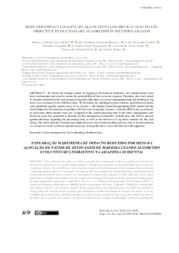Reduced-impact logging by allocating log-decks using multiobjective evolutionary algorithm in Western Amazon.
Reduced-impact logging by allocating log-decks using multiobjective evolutionary algorithm in Western Amazon.
Author(s): ISAAC JÚNIOR, M. A.; BARBOSA, B. H. G.; GOMIDE, L. R.; CALEGARIO, N.; FIGUEIREDO, E. O.; MORAS FILHO, L. O.; MELO, E. de A.; DANTAS, D.
Summary: To reduce the damage caused by logging in the Amazon rainforest, new metaheuristics have been implemented and tested to ensure the sustainability of this economic segment. Therefore, this study aimed to compare alternatives for road sizing and log deck allocation. In a forest management unit, the skidding to log decks was evaluated in two diff erent areas. To determine the skidding/log deck relation, georeferenced points were generated equally spaced every 50 m. In area 1, the Integer Linear Programming (ILP) model and the Multi-Objective Evolutionary Algorithm (MOEA) were compared. In area 2, only the MOEA was considered. In both areas, these models were also compared to the current planning used in the forest management unit. Solutions were then generated to identify the best management alternative. In both areas, the MOEA showed greater efficiency regarding the processing time, as well as the reduction of log decks number and the road sizing. The multi-objective evolutionary approach assists the decision-making process, due to the presentation of alternatives based on Pareto-optimal solutions, making the choice more flexible and well supported. Com o objetivo de reduzir os danos causados pela exploração madeireira na floresta amazônica, novas meta-heurísticas vem sendo implementadas e testadas para garantir a sustentabilidade desse segmento econômico. Assim, este trabalho tem como objetivo comparar alternativas para o dimensionamento de estradas e para alocação de pátios de estocagem de madeira. Em uma unidade de manejo florestal, o deslocamento da exploração de árvores para os pátios de estocagem de madeira foi avaliado em duas diferentes áreas. Para determinar a relação exploração de árvores / pátios de estocagem de madeira, pontos georreferenciados foram gerados igualmente espaçados a cada 50 m. Na área 1, o modelo de Programação Linear Inteira (ILP) e o Algoritmo Evolutivo Multiobjetivo (MOEA) foram comparados. Na área 2, apenas o MOEA foi considerado. Em ambas as áreas, esses modelos também foram comparados com o planejamento executado na unidade de manejo florestal. Soluções foram geradas para identificar a melhor alternativa de manejo. Em ambas as áreas, o MOEA apresentou maior eficiência quanto ao tempo de processamento, bem como na redução do número de pátios de estocagem de madeira e no dimensionamento das estradas. A abordagem evolutiva multiobjetivo auxilia o processo de tomada de decisão, devido à apresentação de alternativas baseadas em soluções Paretoótimas, tornando a escolha mais flexível e bem fundamentada.
Publication year: 2021
Types of publication: Journal article
Unit: Embrapa Acre
Keywords: Algoritmo Evolutivo Multiobjetivo (MOEA, Computer software, Cubiertas de troncos, Dimensionamento da estrada, Dimensionamiento de la carretera, Estrada Rural, Extração da Madeira, Fazenda Cipoal, Forest management unit, Forest roads, Impacto Ambiental, Impacto reduzido, Linear programming, Log decks, Logging, Madeira, Meta-heurística, Metaheuristics, Multi-Objective Evolutionary Algorithm (MOEA), Programa de Computador, Programação Linear, Pátio de estocagem, Reduced-impact, Redução, Road sizing, Unidade de manejo florestal
Observation
Some of Embrapa's publications are published as ePub files. To read them, use or download one of the following free software options to your computer or mobile device. Android: Google Play Books; IOS: iBooks; Windows and Linux: Calibre.
Access other publications
Access the Agricultural Research Database (BDPA) to consult Embrapa's full library collection and records.
Visit Embrapa Bookstore to purchase books and other publications sold by Embrapa.

